The AMD Kabini Review: A4-5000 APU Tested
by Jarred Walton on May 23, 2013 12:00 AM ESTKabini Windows 8 Laptop Performance
With the SoC and “lighter device” benchmarks out of the way, let’s also look at what Kabini offers for a full laptop experience. Let me preface this section by simply stating many of our laptop benchmarks really aren’t a good fit for an APU like Kabini—e.g. doing 3D rendering or x264 HD encoding on such a chip is just asking for poor performance. We’re also looking at different OS configurations (Windows 7 vs. Windows 8, IE8/9 vs. IE10), so there’s a slightly higher potential for margin of error here.
Our current list of laptops includes AMD's Brazos E-350 (MSI X370), Kabini A4-5000, and Trinity A10-4600M; on the Intel front we have i7-3517U (Dell XPS 12) and Pentium 2020M (a late addition when we managed to get a laptop for short-term testing). Both of the Intel chips are 22nm parts, but note that the Pentium chip is a 35W part. Sadly, we have not yet been able to get a Pentium 2117U as a comparison. [Note: Some laptops are still being tested on some of the benchmarks; their scores will be added/updated as they complete.]
We do want to see what sort of gains are present relative to Brazos, however, so let’s get started. We’re presenting an abbreviated look at performance here, but we have the full set of benchmark results in Mobile Bench, including some of our older benchmarks that we’ve run against Brazos and other laptops prior to 2013. There are two main questions to consider for each benchmark: how much faster is Kabini than Brazos (and where does it place relative to other options), and does Kabini provide enough performance to handle the task represented by the benchmark?
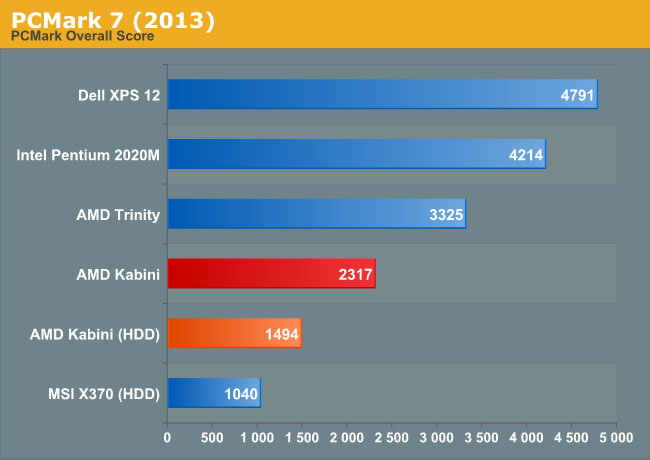
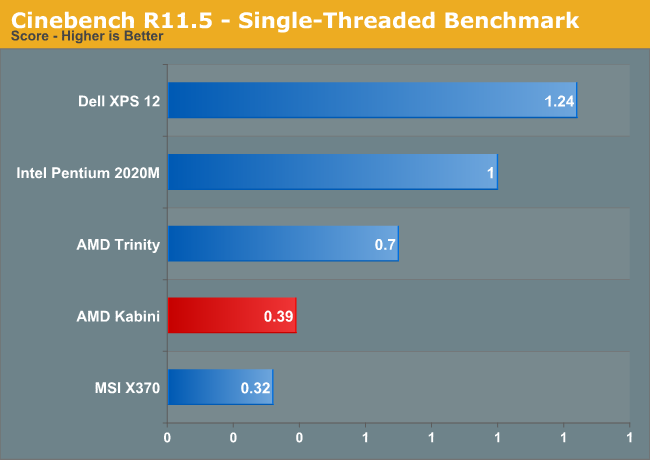
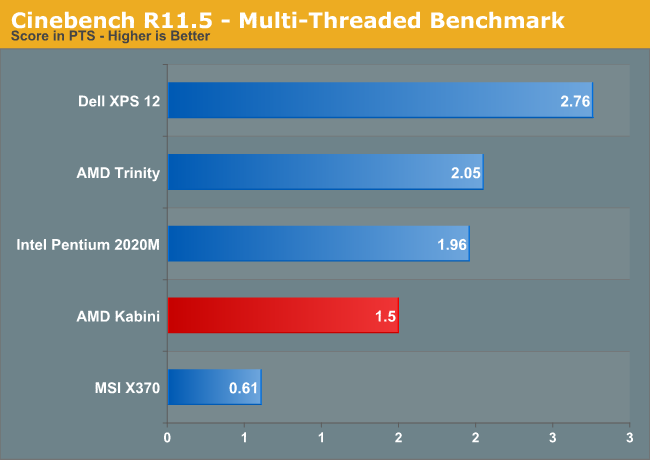
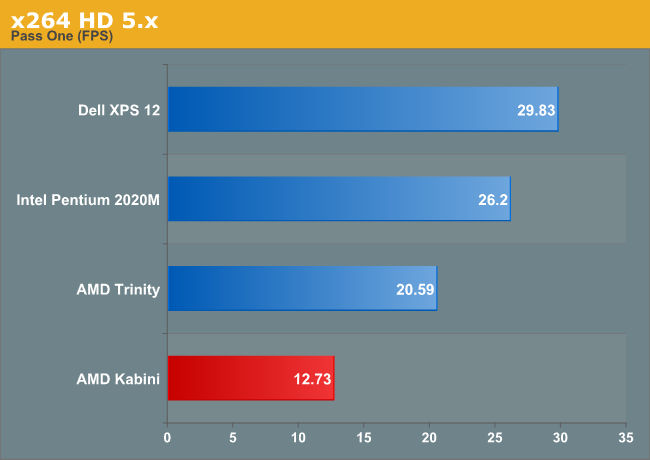
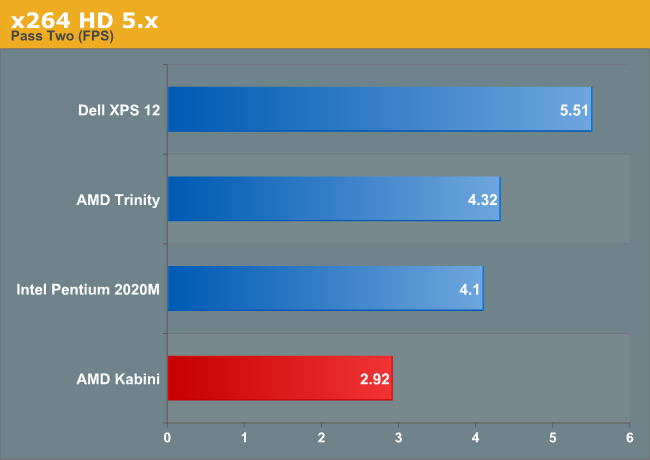
Starting with PCMark 7, we have both HDD and SSD results. As usual, the presence of an SSD boosts performance in the overall score by more than 50%, so Kabini with an SSD can feel far more responsive than Ivy Bridge with an HDD, depending on the task. Relative to Brazos, even with an HDD on both laptops, Kabini is nearly 50% faster. ULV Ivy Bridge on the other hand offers twice the performance of Kabini in the overall score, though Quick Sync skews that pretty heavily. Looking at the individual results, ULV IVB is around 30-50% faster on most CPU tasks, and it’s even a bit faster on the GPU side in most areas as we’ll see in a moment.
Update: We've added Pentium 2020M to the above charts, which lacks Quick Sync support and runs at a maximum clock speed of 1.8GHz. It's clearly slower than the i7-3517U in the Dell XPS 12, but it's also still a healthy step up from Kabini in terms of performance. The 2020M is a full 35W part, like the A10-4600M, and it tends to slightly outperform Trinity on CPU tasks while trailing in GPU performance. On the Kabini front, however, even the Pentium 2020M is able to lead on nearly all the performance metrics.
The CPU performance testing of x264 HD 5.x and Cinebench confirm the CPU deficit AMD faces with Kabini. In heavily threaded workloads, Ivy Bridge ULV is 50-100% faster, but the real problem is in the single-threaded workloads. A single Jaguar core in Cinebench manages to score just 0.39 compared to IVB ULV’s score of 1.24, so worst-case Kabini is one third the speed of Ivy Bridge. Standard Voltage Trinity APUs are likewise a big step up from Kabini, offering roughly twice the CPU performance in some cases. Of course, the power draw from standard Trinity tends to be far higher than Kabini.

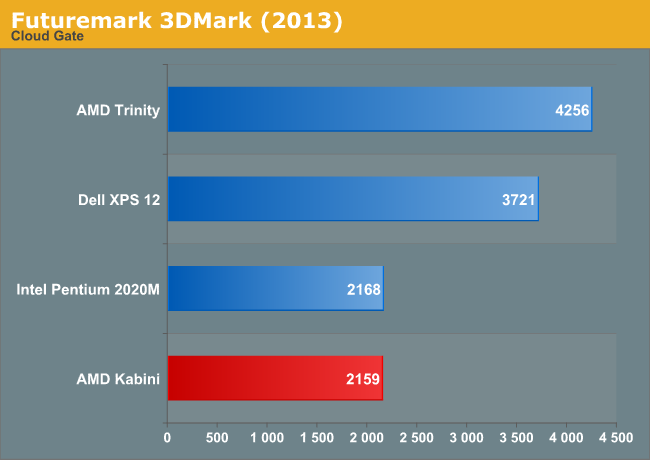
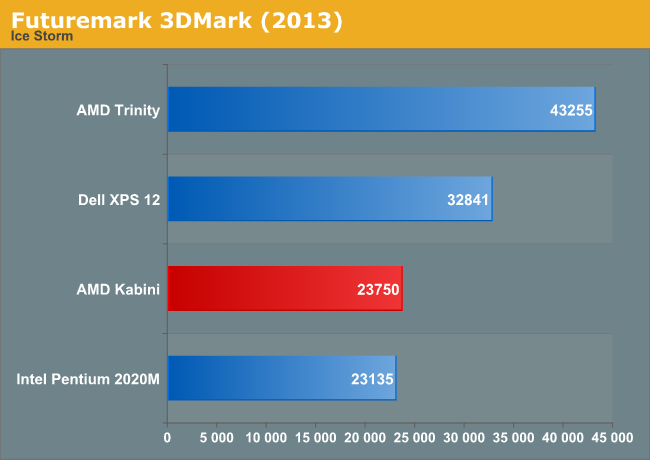
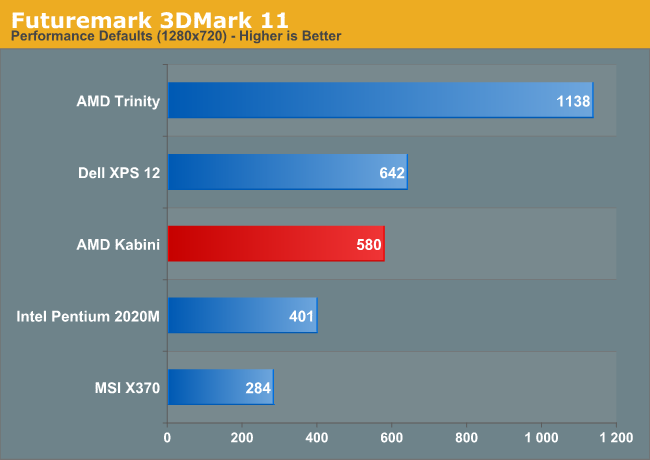
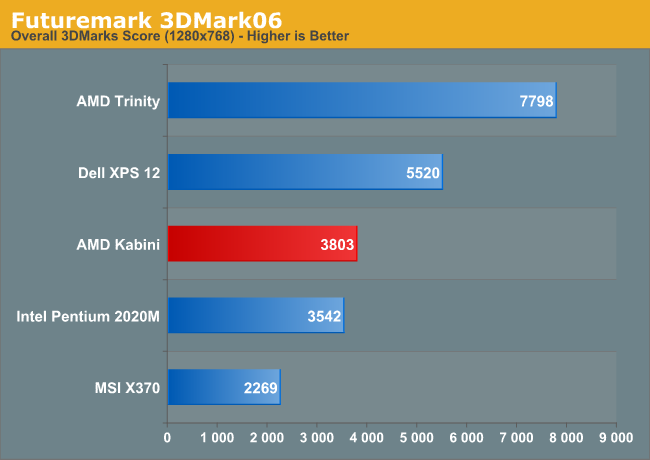
Quickly looking at the 3DMark results, if you were hoping Kabini would be fast enough to handle modern games at moderate detail settings, the relative standings in 3DMark should help prep you for what’s to come. The A10 Trinity can handle many titles at moderate details, but even it struggles with many of the latest releases; Kabini has about a third of the total GPU compute performance of Trinity, and while it’s a bit faster than that in some games, for the most part it’s best suited for older games that don’t require as much from the CPU or GPU.
As for Intel's chips, while the Core i7 ULV part ends up faster than Kabini, the same can't be said of the Pentium 2020M; it's a tie in some tests but falls behind (sometimes significantly, e.g. 3DMark 11) in others. As neither chip is really fit for high-end graphics work, it's not really a major concern. If you want decent graphics performance, you're going to want more than either Kabini or Ivy Bridge has to offer.










130 Comments
View All Comments
takeship - Thursday, May 23, 2013 - link
True, price will keep most budget buyers out of Haswell powered ultrabooks. Not so for the now-on-clearance-sale Ivy Bridge Dell & HPs though. And in that market Kabini loses most of it's price advantage, while still giving worse performance & marginal battery life improvements. There it's the new $500 plastic Kabini laptop, vs. the $600 aluminum IVB Lenovo. I just don't see that being a win.Gaugamela - Thursday, May 23, 2013 - link
The HP Pavilion 11 Touchsmart costs 400$. It has a 10-point touchscreen. So, the 400$ touch enabled Kabini seems mighty atractive compared to the 600$ Lenovo now.axien86 - Thursday, May 23, 2013 - link
Touche! Thanks to AMD for providing alternatives to Intel's Atoms and higher priced CPUs.
kyuu - Thursday, May 23, 2013 - link
Besides the price issue, you seem to be quite missing the point of a low-power architecture like Jaguar. Let me know when ULV Ivy Bridge can scale down to 3.9W.Also, a lot of people seem to have trouble comprehending the fact that TDP doesn't really have much in common with the actual power draw of the chip (or the heat output). We've already seen what happens when you try to cram even the lowest wattage Ivy Bridge into a modern tablet form factor: high temperatures w/ fans, low battery life, high price.
Gaugamela - Thursday, May 23, 2013 - link
It competes with an Sandy Bridge ULV i3 and it gets quite close to a i3 Ivy, while offering better battery life.Seems like a clear proposition to me: if Pentium like performance is what you need this offers you that and better GPU performance. Perfect for the low-end of the ultrathin/ultrabook market.
andrewaggb - Thursday, May 23, 2013 - link
yeah, pretty much how I read it as well. Assuming you can afford to pay an extra $200 dollars there's not much reason (other than possibly graphics drivers) to not get haswell instead.aryonoco - Thursday, May 23, 2013 - link
Very interesting article. Just a few notes:I'm not sure that Exynos 5250 is the best representative of Cortex A15. For one, it's dual core without any HT so at a massive disadvantage in a test like Kraken. Secondly, it came out in actual device in the market about 7 months ago. By the time Kabini shows in products, it will probably be over 8 months later. We'll have other Cortex A15 parts by then, and if the Tegra 4 Kraken scores that I'm hearing (~6000) is right, and if something Tegra 4 is using about half as much power as this 15W Kabini, then Kabini suddenly doesn't look that competitive.
Of course as you say, the success of Kabini will depend on what OEMs do with it, but traditionally these cheap AMD parts find themselves in devices that are compromised in everyway. Even if we get a 1080p screen this time around (which I'm hopeful), we'll still have to deal with sub-optimal keyboards, trackpads that work only half the time, and other cost-cutting measures we are familiar with. For this to succeed, someone needs to put it in a Ultrabook-style laptop, with good display, good keyboard and no software glitches, and price it under $500. That's a tall task.
HP just announced a very interesting Slatebook X2 running Android (not skinned) on Tegra 4 with 1080p IPS screen and a Transformer-style detachable dock for $479, including the dock (sidenote, I was disappointed there was no coverage of this on AT). If the performance claims for Tegra 4 (and other future more optimized Cortex A15 parts) are accurate, with such devices on the horizon, will there even be a cheap Ultrabook-style market left for Kabini to compete in? Can Kabini find its way into similar designs by major OEMs? I hope, for everyone's sake that AMD can succeed, but I am doubtful.
JarredWalton - Thursday, May 23, 2013 - link
I certainly think Kabini can go into the same designs that we're seeing Tegra 4 target. Which will end up being faster? That's a different question, and I'm not sure we have enough information to come to a conclusion right now. If Kabini/Temash can get into tablets sooner rather than later, they've got a chance. If it takes 6-8 months, you're right: it may not matter at that point.Gaugamela - Thursday, May 23, 2013 - link
HP just announced their back to school products and there is a successor to the HP dm1 that will cary A4's and A6's.Exophase - Friday, May 24, 2013 - link
No Cortex-A15 has HT, and Kraken is single threaded anyway. I think Kraken just isn't a great benchmark. Although its makers say it's a lot better than Sunspider it shares a lot of the same sorts of problems:1) It's Javascript which has its own unique (pretty severe) overheads which can dominate run-time to the extent that it drowns out a lot of the variation from the type of JS code you're running. JS is used and it's important, but even today on good JITs most JS code is several times (think 5 times) slower than an equivalent written in something like C++ or even Java, making it a bad representation of performance of more efficient software.
2) Much of what it does - path finding, signal processing, and crypto - is not the kind of stuff Javascript is usually used for.
3) Its test durations are really short, which is bad for benchmarks in general but can be especially bad for JITs where it
4) The variation in current browsers is extreme (http://arstechnica.com/civis/viewtopic.php?f=8&... where you can see some tests are substantially faster and others substantially slower. This again highlights the big overheads of Javascript and the impact of different JIT strategies, but also that the state of performance is still pretty volatile. A similar sort of variation could manifest between different backends (ie, x86 vs ARM) even for the same browser.
Cross-architecture comparisons are hard and I don't blame people for using JS when there's not a lot else available (although at least some other inclusions would be nice).. but you shouldn't draw a very broad conclusion from a Kraken comparison alone. And if you did that it'd also make the Kabini vs i5 comparison look a lot worse than a lot of other tests show.